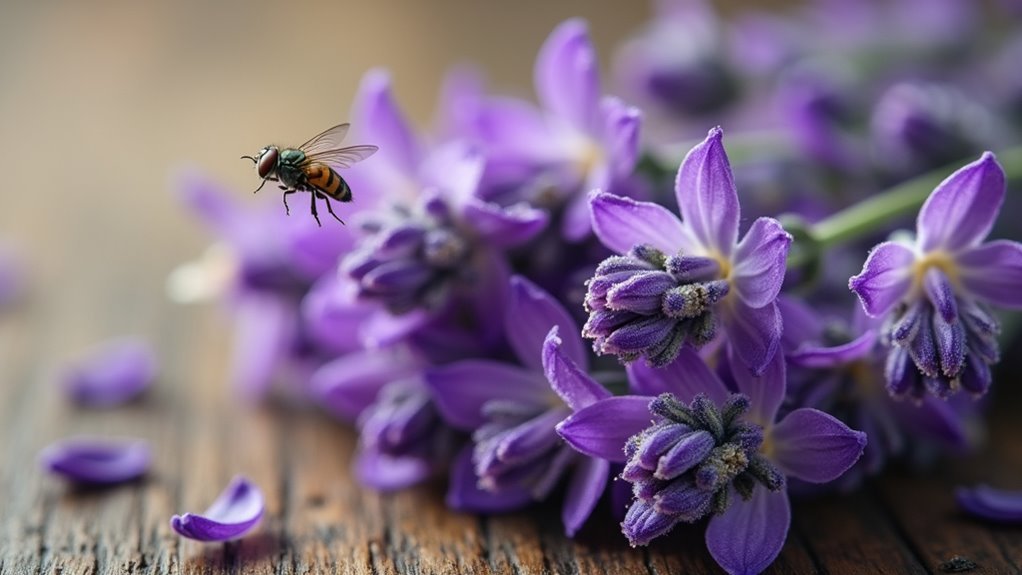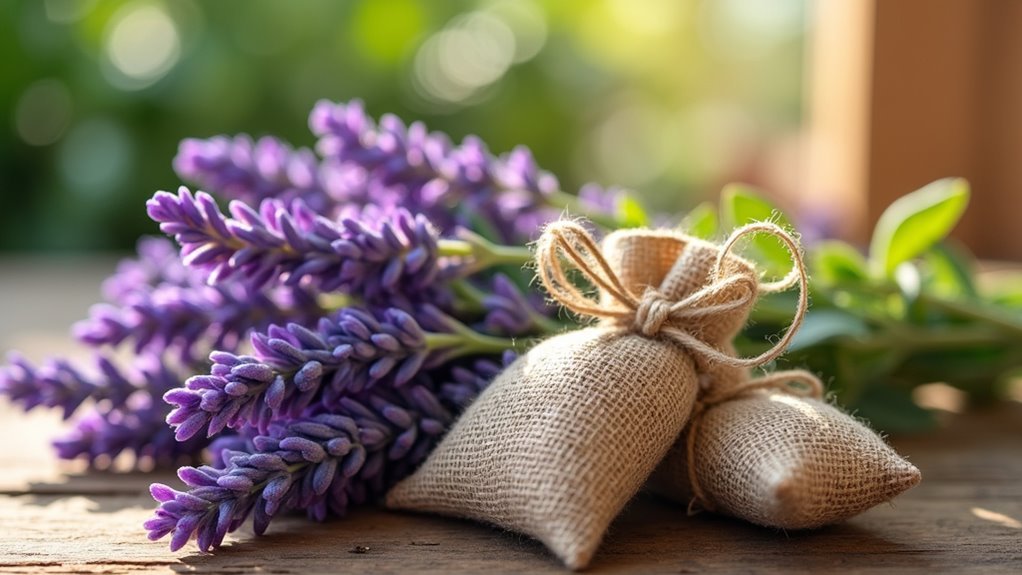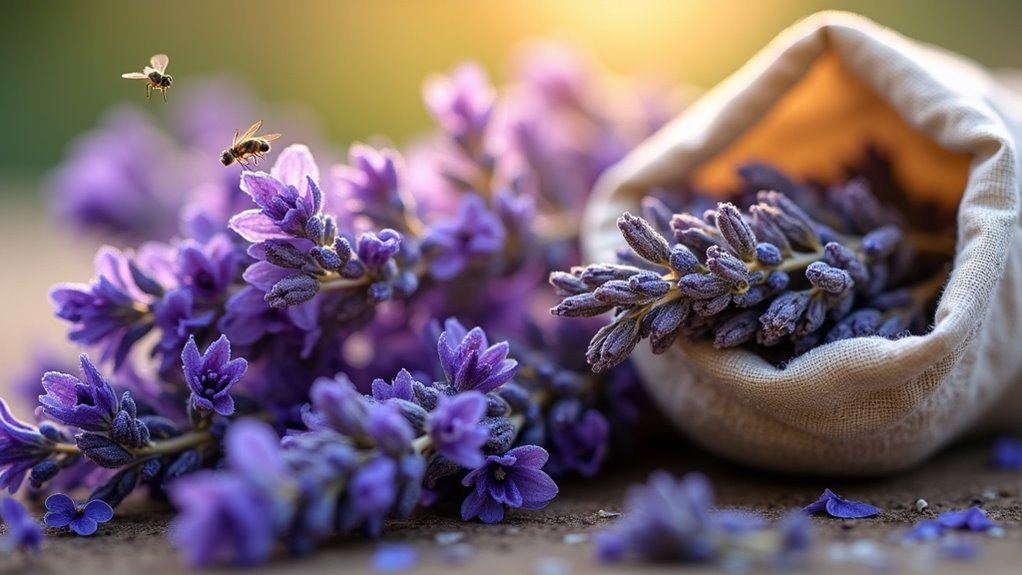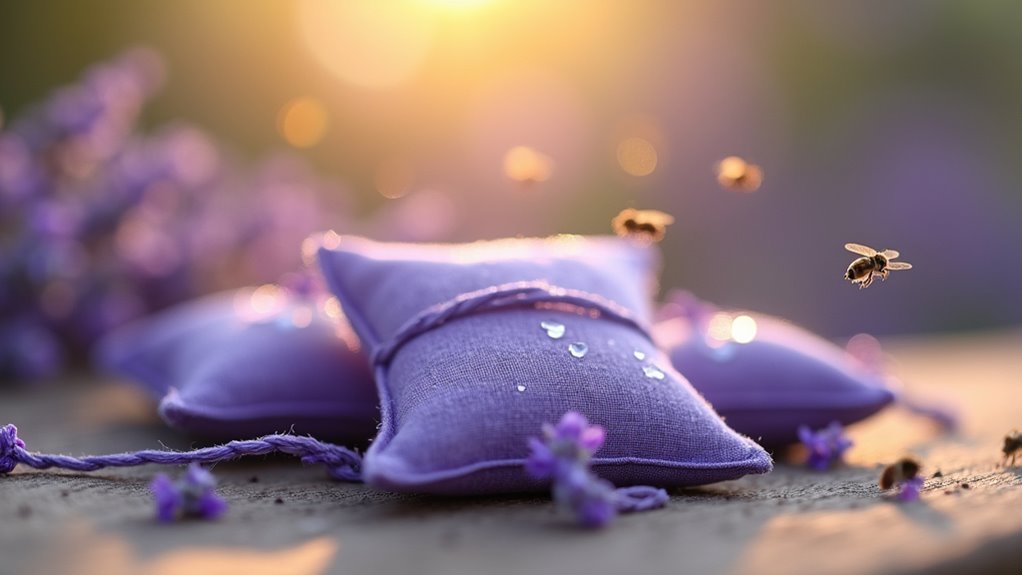You’ll find lavender sachets repel flies effectively through two powerful compounds: linalool and linalyl acetate. These natural chemicals disrupt flies’ sensory receptors, overwhelming their olfactory systems and impairing their navigation abilities. Linalool acts as a natural insecticide targeting adult flies, while linalyl acetate enhances the aromatic repellent effect. The concentration matters—linalool levels between 20% to 50% considerably boost repelling properties. Understanding proper placement, maintenance, and integration with other natural methods can maximize your fly control success.
Understanding Lavender’s Natural Fly-Repelling Properties

When you’re searching for a natural solution to keep flies at bay, lavender sachets offer an effective and aromatic alternative to chemical repellents.
Lavender essential oil contains powerful compounds called linalool and linalyl acetate that naturally repel flies through their distinctive scent. These essential oils work by disrupting flies’ sensory receptors, making your space uninviting to these unwanted guests.
Linalool and linalyl acetate in lavender disrupt flies’ sensory receptors, creating a natural aromatic barrier that keeps these pests away.
What makes lavender particularly valuable for pest control is its dual-purpose nature. While it effectively handles fly control, you’ll also enjoy the calming fragrance that enhances your living environment.
The aromatic properties don’t just mask odors – they actively create a barrier that flies avoid. This natural approach proves especially beneficial when you want to maintain a chemical-free home while still achieving reliable results against various flying insects.
The Science Behind Linalool and Linalyl Acetate Compounds
You’ll find that lavender’s effectiveness against flies stems from two key compounds: linalool and linalyl acetate, which work together to create a powerful natural deterrent.
These compounds disrupt flies’ sensory systems and reproductive behaviors, with linalool acting as the primary insecticide while linalyl acetate enhances the overall repellent effect.
The concentration of these compounds in your lavender sachets directly impacts their effectiveness, making understanding their chemical makeup essential for maximizing fly control.
Chemical Composition Analysis
Although lavender’s sweet fragrance might seem like simple perfumery to you, the plant’s fly-repelling power stems from two specific chemical compounds that pack a scientific punch.
When you analyze lavender’s chemical makeup, you’ll discover that linalool and linalyl acetate work together as nature’s pest control system. These compounds disrupt flies’ sensory receptors, effectively confusing their navigation abilities.
Linalool acts as a natural insecticide, targeting adult flies more efficiently than larvae, while linalyl acetate enhances both the pleasant aroma and insect-repelling properties.
The concentration of these compounds in essential oil directly determines how effectively your lavender sachets will repel flies, making chemical composition analysis vital for understanding why this natural solution works.
Insect Repellent Mechanisms
Since flies rely heavily on their sensory receptors to locate food and navigate their surroundings, linalool and linalyl acetate create a biochemical interference that fundamentally blinds these pests to their environment.
When you use lavender sachets, these compounds don’t just mask scents – they actively disrupt the flies’ navigation system by overwhelming their olfactory receptors.
Linalool acts as a powerful insect repellent by targeting adult flies’ reproductive capabilities while interfering with their feeding behaviors.
The lavender essential oil creates a natural barrier that’s pleasant to you but completely disorienting to insects.
What makes this mechanism particularly effective is linalool’s dual action: it repels existing flies while reducing their ability to reproduce in treated areas, creating long-term protection for your space.
Compound Concentration Effects
The effectiveness of lavender sachets depends directly on the concentration levels of linalool and linalyl acetate within the essential oil. You’ll find that linalool concentrations ranging from 20% to 50% considerably impact your sachet’s insect-repelling properties. Higher concentrations create stronger barriers against flies, as linalool disrupts their sensory receptors more efficiently.
When you choose lavender essential oil with ideal compound levels, you’re ensuring maximum protection for your space.
The linalyl acetate component works alongside linalool, functioning as a natural insecticide that enhances overall repellent strength. You can’t overlook this compound’s dual role – it maintains lavender’s pleasant fragrance while boosting its protective capabilities.
Together, these concentrated compounds transform simple fabric sachets into powerful fly deterrents that guard your home naturally and efficiently.
How Lavender Sachets Disrupt Fly Sensory Navigation
When you place lavender sachets in your space, the linalool they release creates a powerful scent barrier that confuses flies’ navigation systems.
You’re fundamentally jamming their olfactory receptors, making it impossible for them to detect the food sources and breeding sites they’re searching for.
This sensory disruption forces flies to abandon treated areas since they can’t rely on their primary navigation tool—their sense of smell.
Linalool Scent Interference
Although flies rely heavily on their keen sense of smell to navigate toward food sources, lavender sachets create a powerful disruption in their sensory world through the release of linalool. This compound acts like a jamming signal, overwhelming the delicate olfactory receptors that flies depend on for survival.
When you place lavender sachets in your space, the linalool scent effectively masks the chemical signatures of decaying organic matter that normally attract these pests.
The interference works because flies can’t distinguish between food odors and the overpowering lavender fragrance. Their sensory system becomes confused, making it nearly impossible to locate potential feeding sites.
This natural repel mechanism forces flies to seek alternative areas, leaving your space relatively pest-free without harmful chemicals.
Olfactory System Disruption
Beyond simple scent masking, lavender sachets create a neurological disruption that fundamentally alters how flies process sensory information. When you place these sachets strategically, the essential oils directly interfere with flies’ olfactory receptors, preventing them from accurately interpreting environmental cues they depend on for survival.
| Disruption Type | Mechanism | Effect on Flies |
|---|---|---|
| Receptor Blocking | Linalool compounds bind to nerve pathways | Cannot detect food sources |
| Signal Confusion | Mixed chemical messages overwhelm sensors | Disoriented navigation patterns |
| Activity Reduction | Neurological stress decreases function | Lowered reproduction and movement |
This disruption goes beyond repelling flies—it actually impairs their ability to function normally. You’ll notice fewer flies because they can’t effectively locate breeding sites or food sources when their sensory navigation system becomes compromised by lavender’s neurological interference.
Creating Effective DIY Lavender Sachets for Fly Control

Creating your own lavender sachets offers a natural and aromatic solution for keeping flies at bay throughout your home.
You’ll need dried lavender flowers containing linalool, which naturally repel flies. Fill small, breathable fabric pouches with 1-2 tablespoons of dried lavender, guaranteeing the scent can escape effectively.
Position your sachets strategically in closets, kitchen cabinets, and near windows and doors where flies typically enter. This placement maximizes their pest-deterrent capabilities throughout key areas.
To maintain effectiveness, lightly crush the dried flowers or add a few drops of lavender essential oil every few weeks to refresh the scent.
Replace sachets entirely every 6-12 months to ensure continued potency and reliable fly control in your living spaces.
Strategic Placement of Lavender Sachets in Your Home
You’ll maximize your lavender sachets’ effectiveness by placing them in specific locations throughout your home.
Focus on high-traffic areas where flies congregate most, particularly your kitchen and pantry where food attracts these pests.
Don’t forget to position sachets near windows and entryways where flies typically enter your living space.
High Traffic Areas
When flies congregate in areas where you spend most of your time, they become more than just a nuisance—they’re a constant irritation that disrupts your daily activities.
Your kitchen and dining room are prime targets for these pests, drawn by food odors and cooking aromas. Placing lavender sachets in these high traffic areas creates an effective defense against unwanted visitors.
The natural repellent properties of lavender work particularly well in these spaces because the pleasant fragrance helps mask the food scents that attract flies.
Position sachets near your stove, dining table, or food preparation areas where you’ll benefit most from their protective effects. This strategic placement guarantees lavender sachets repel flies while maintaining a fresh, inviting atmosphere in your home’s busiest rooms.
Kitchen and Pantry
Since kitchens and pantries contain the strongest food odors that attract flies, they’re essential locations for lavender sachets placement.
You’ll want to position these natural deterrents strategically throughout these areas to repel flies effectively.
Place lavender sachets inside kitchen cabinets and pantry shelves to mask food odors that draw flies.
Position them near trash cans where unpleasant smells accumulate, creating a protective barrier against infestations.
Hang sachets in window sills and doorways to prevent flies from entering your kitchen and pantry spaces.
For maximum effectiveness, refresh your lavender sachets every few weeks to maintain their potent aroma.
Combine this natural approach with proper food storage in sealed containers.
This dual strategy creates an unwelcoming environment that greatly reduces fly activity.
Window and Entryways
Windows and entryways serve as your home’s primary defense points against fly invasions, making them perfect locations for lavender sachet placement.
Strategic positioning at these entry points maximizes lavender’s essential oil effectiveness while creating an aromatic barrier that disrupts flies’ navigation systems.
You’ll want to focus on these key placement areas:
- Door frames – Hang sachets directly above or beside main entrances
- Window sills – Position sachets where air circulation spreads the scent
- Sliding doors – Attach to tracks or nearby walls for maximum coverage
- Screen doors – Place on both sides to create double protection
- Garage entries – Don’t forget secondary access points flies commonly use
Replace sachets every few weeks to maintain potent essential oil concentration.
This natural approach to repel flies transforms necessary pest control into an enjoyable home enhancement.
Comparing Lavender Sachets to Other Natural Fly Deterrents
While many natural fly deterrents exist, lavender sachets offer unique advantages that set them apart from other eco-friendly options.
Unlike repellent spray that requires frequent reapplication, lavender sachets provide continuous protection through their essential oil content rich in linalool and linalyl acetate. You’ll find they’re more convenient than maintaining live plants that need specific growing conditions or seasonal care.
When you’re dealing with a persistent fly problem, lavender sachets prove more versatile than single-location solutions like citronella candles.
You can place them anywhere – closets, kitchens, or drawers – without worrying about watering or sunlight requirements. They’ll complement other natural deterrents like basil or eucalyptus, creating layered protection that’s both effective and aromatic throughout your home.
Maximizing Potency: Fresh Vs Dried Lavender in Sachets

When you’re choosing between fresh and dried lavender for your sachets, the potency difference becomes immediately apparent through scent intensity and fly-repelling effectiveness.
Fresh lavender delivers superior results because it retains higher levels of essential oils like linalool, which effectively repel flies. You’ll notice the aromatic compounds work faster, releasing stronger concentrations immediately after harvest.
Fresh lavender’s higher essential oil content delivers immediate, potent fly-repelling power that dried varieties simply cannot match.
Dried lavender sachets offer convenience but provide more subdued scents over time, making them less potent than fresh alternatives.
Consider these strategies to maximize effectiveness:
- Replace dried lavender sachets regularly for consistent repellent power
- Harvest fresh lavender during peak bloom for maximum essential oil content
- Combine both forms to maintain stronger, longer-lasting aromas
- Crush sachets gently to release additional oils when needed
- Store dried lavender properly to preserve remaining potency
Combining Lavender With Other Fly-Repelling Herbs
Beyond optimizing lavender’s natural potency, you can dramatically boost your sachets’ fly-repelling power by combining lavender with complementary herbs. These strategic blends create enhanced scent barriers that make it challenging for flies to locate food sources or breeding sites.
| Herb Combination | Primary Benefits | Target Pests |
|---|---|---|
| Lavender + Basil + Rosemary | Synergistic scent blend | Various insects |
| Lavender + Bay Leaves | Strong aromatic deterrent | Flies and general pests |
| Lavender + Mint + Thyme | Enhanced insecticidal properties | Flies and mosquitoes |
When you mix these fly-repelling herbs, their diverse aromatic profiles work together to repel flies more effectively than lavender alone. Crushed bay leaves provide potent aromas, while peppermint oil offers insecticidal qualities. Thyme’s natural insecticide properties further amplify your lavender sachets’ effectiveness against multiple pest species.
Seasonal Effectiveness of Lavender Sachets Against Different Fly Types
As seasons change throughout the year, your lavender sachets demonstrate varying levels of effectiveness against different fly species based on their activity patterns and behavioral shifts.
The linalool compounds in lavender work as a natural repellent that adapts seasonally to combat different fly challenges.
Your lavender sachets provide year-round protection through:
Natural lavender sachets deliver consistent fly protection across all seasons with their powerful linalool compounds working year-round.
- Spring revival – Deterring flies drawn to decomposing organic matter as temperatures rise
- Summer strength – Maintaining peak potency when house flies and fruit flies are most aggressive
- Fall fortress – Blocking flies seeking warm indoor shelter before winter arrives
- Continuous coverage – Delivering weeks of persistent aromatic protection without replacement
- Multi-species defense – Targeting various fly types with consistent linalool effectiveness
This seasonal adaptability makes lavender sachets your reliable, natural solution against flies throughout changing weather patterns.
Maintenance and Replacement Schedule for Lavender Sachets
While your lavender sachets work reliably across all seasons, their effectiveness depends on proper maintenance to keep the aromatic compounds at peak strength.
You’ll need to replace your sachets every 1-2 months as the scent naturally diminishes over time. Between replacements, you can refresh them by gently squeezing or shaking to release more trapped essential oils from the dried lavender.
Store your sachets in cool, dark places to extend their potency and longevity. If they lose their scent before replacement time, add a few drops of lavender essential oil directly to rejuvenate their repellent properties.
Check regularly for moisture or mold, which compromises efficacy against flies and other insects. This maintenance schedule guarantees consistent fly deterrence.
Limitations and Realistic Expectations for Lavender Fly Control
Though lavender sachets offer a natural approach to fly deterrence, you’ll find their effectiveness has clear boundaries that require realistic expectations.
Lavender sachets provide gentle, natural fly deterrence but won’t solve serious infestations without proper cleaning and realistic expectations.
While linalool in lavender sachets can deter flies, these natural solutions won’t eliminate heavy infestations or replace proper sanitation. You’ll need to limit your expectations and understand their role as supportive tools rather than standalone solutions.
Consider these emotional realities of lavender fly control:
- Frustration awaits when heavily infested areas overwhelm lavender’s gentle power
- Disappointment strikes if you expect complete elimination without cleaning practices
- Hope diminishes as sachets weaken over time without regular replacement
- Relief comes when combining lavender with traditional pest management
- Success emerges through realistic expectations and thorough approaches
Effective fly control requires lavender sachets as part of broader strategies including sanitation and waste management.
Frequently Asked Questions
How Does Lavender Repel Flies?
You’ll find lavender repels flies through its linalool and linalyl acetate compounds. These create strong aromas that flies can’t tolerate, while you enjoy the pleasant scent that effectively deters insects.
What Scent Repels Flies the Most?
You’ll find citrus scents like lemon and orange repel flies most effectively. Eucalyptus, peppermint, and lavender also work well. These strong, clean aromas overwhelm flies’ sensitive smell receptors, driving them away naturally.
How Do You Make Lavender Bug Repellent?
You’ll mix 10-15 drops of lavender essential oil with 2 cups of water in a spray bottle. Add a tablespoon of witch hazel for stronger effectiveness, then spray around areas where flies gather.
Do Lavender Sachets Keep Bugs Away?
Yes, you’ll find lavender sachets effectively keep bugs away. They release linalool and linalyl acetate oils that repel flies, moths, and other insects while creating a pleasant aroma you’ll enjoy in your home.
In Summary
You’ll find lavender sachets work best when you understand their limitations and use them strategically. Place fresh sachets near entry points, refresh them every 4-6 weeks, and combine them with other natural repellents for maximum effectiveness. While they won’t eliminate severe infestations, they’ll considerably reduce fly activity in your home. Remember, consistency in placement and maintenance is key to achieving the natural fly control you’re seeking.





Leave a Reply